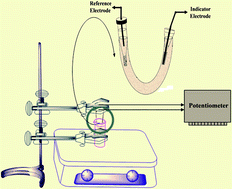In this paper, for the first time, a combination of hollow fiber based liquid 3-phase microextraction with a potentiometric method was applied as a highly selective and sensitive method of analysis. Desipramine, as a model compound, was extracted from a small volume in the presence of 0.10 mol L−1 NaOH (donor solution) through a thin phase of propyl benzoate inside the pores of a polypropylene hollow fiber and finally into a 10 μL acidic acceptor solution inside the hollow fiber. Two microelectrodes were designed and inserted into the two ends of a hollow fiber inside the acceptor solution. Potentiometric analysis was performed in situ within an extraction time of 15 min; the final stable signal was used for analytical application. Under the optimized conditions, an enrichment factor of 296 was achieved and the relative standard deviation (RSD%) of the method was 4.5%. The calibration curve was obtained in the range of 3.0 × 10−5 to 3.4 × 10−8 mol L−1 with a reasonable linearity (R2 > 0.9849) and a limit of detection (LOD) of 3.1 × 10−8 mol L−1. Finally, the applicability of the proposed method was evaluated by extraction and determination of desipramine in plasma and urine samples without any special pretreatment.

You have access to this article
 Please wait while we load your content...
Something went wrong. Try again?
Please wait while we load your content...
Something went wrong. Try again?


 Please wait while we load your content...
Please wait while we load your content...